Owl
The owl can rotate its head some 270 degrees
Advertisement
Owl Scientific Classification
Read our Complete Guide to Classification of Animals.
Owl Conservation Status
Owl Facts
- Prey
- Insects, rodents, rabbits, hares, and fish
- Name Of Young
- Hatchlings
- Group Behavior
- Group
- Family units
- Fun Fact
- The owl can rotate its head some 270 degrees
- Estimated Population Size
- Unknown
- Biggest Threat
- Habitat loss
- Most Distinctive Feature
- The massive front-facing eyes
- Other Name(s)
- Hooters
- Gestation Period
- 1-2 months
- Litter Size
- Up to 12 eggs
- Habitat
- Grasslands, forests, swamps, and others
- Predators
- Birds of prey, cats, and humans
- Diet
- Carnivore
- Type
- Bird
- Common Name
- Owl
- Location
- Worldwide
Owls are exceptional hunters that can spot potential prey from up to half a mile away.
Owls are a diverse group of animals that belong to their own separate order. There are more than 200 recognized species all around the world. With their highly developed binocular vision and accurate flying abilities, they have several unique adaptations that help them hunt for prey at night. This article will cover some interesting facts about the identification, habitat, and features of the owl.
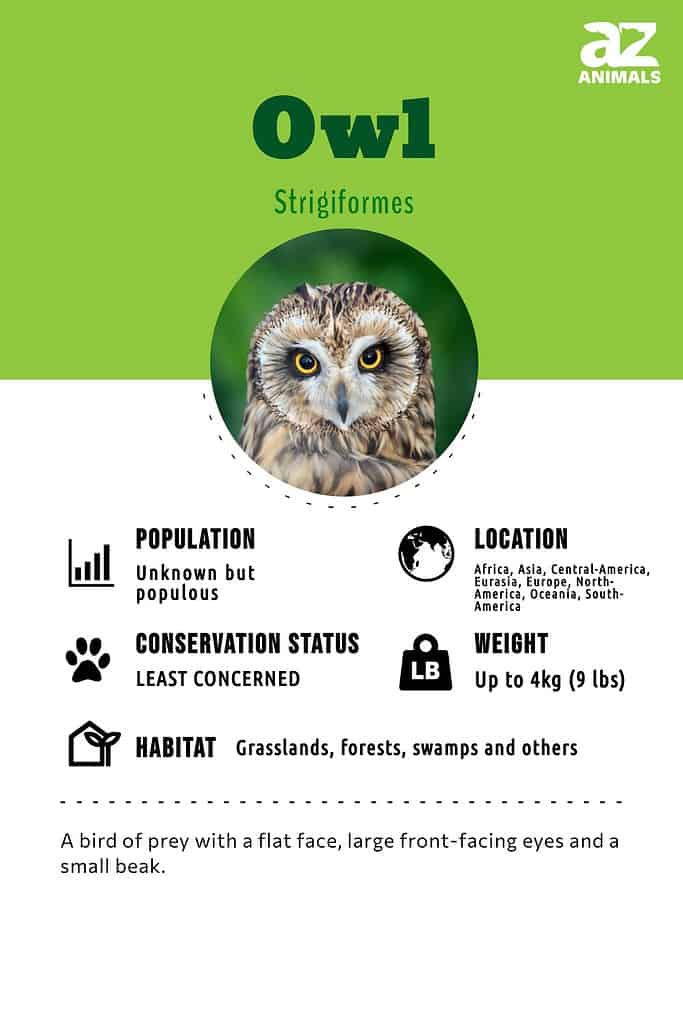
4 Incredible Owl Facts!
- One of the most amazing facts about owls is that they have the ability to rotate their heads up to 270 degrees. Normally this would cut off circulation to the brain and eyes, but their heads will pool up blood to prevent this from happening. Their amazing ability has evolved to compensate for their static and immobile eyes.
- These birds are not the fastest flyers in the world, but it’s estimated that some species can reach flight speeds of around 40 miles per hour in short bursts. They fly on a straight path by flapping their wings steadily. Then they make a short upward glide to land on the perch.
- Owls are known to have asymmetrical or uneven ear placement. This means one ear is located above the “blind cavity” of the head and the other below it. This is thought to make the ears sensitive enough to capture a wider range of different frequencies.
- These birds regurgitate the indigestible parts of their prey in the form of pellets.
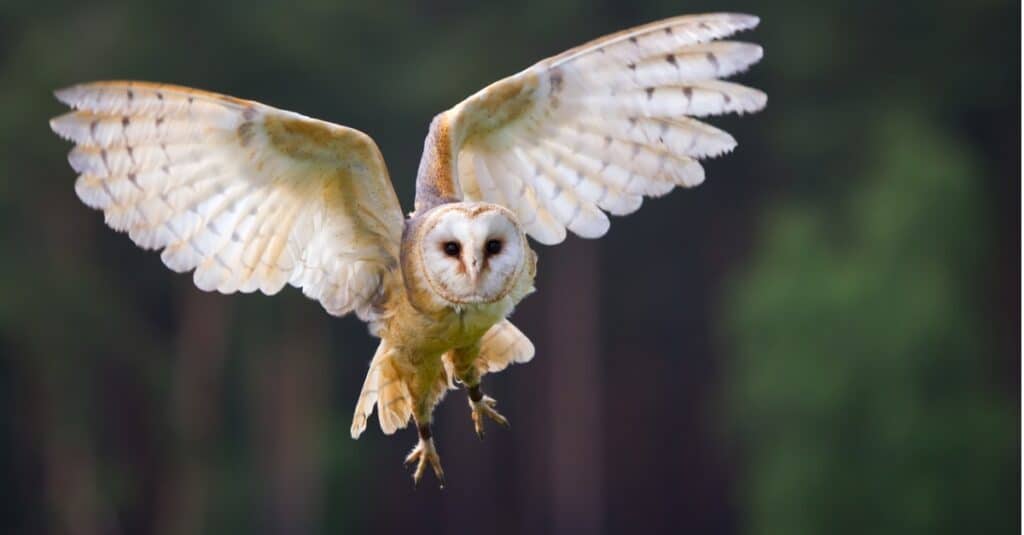
Owls can reach flight speeds of 40 mph.
©iStock.com/M-Reinhardt
Scientific Name and Species
The scientific name of the owl is Strigiformes. It is the combination of two Latin words: strix means owl and formes forms. There are two main families: the true owls and the barn owls. The main difference between them is the latter’s heart-shaped face and longer feet. These families can be further divided into many other types of genera.
There are around 250 species of owls around the world including:
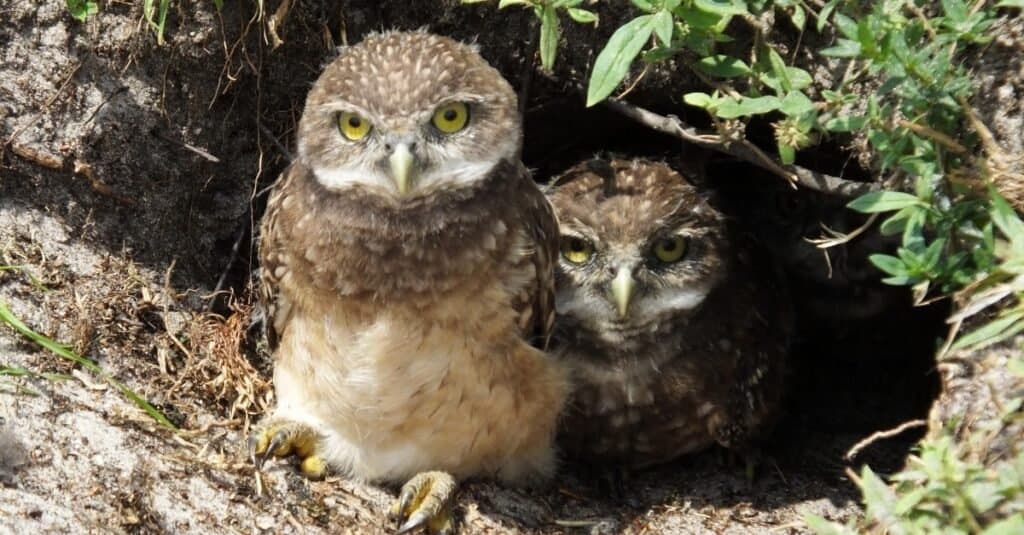
The burrowing owl prefers to nest in burrows rather than trees.
©iStock.com/passion4nature
- Eastern Screech Owl – Found mostly in the eastern U.S., northeastern Mexico, and southeastern Canada, this little owl has a body length of 6-10 inches and a wingspan of 10 inches. Nocturnal, with short ear tufts and yellow eyes, these owls are often found in areas and parks with lots of trees.
- Snowy Owl – Also called the polar or white owl, the snowy owl is considered a vulnerable species with a population of less than 30,000. This large owl is native to the Arctic regions of Europe, North America, and Asia. This owl’s diet is primarily lemmings which they hunt in the snow.
- Burrowing Owl – This little owl is small with long legs and brown feathers spotted with white. Found in Central and South America, Mexico, North America, and southern Canada, this owl prefers to next in burrows rather than trees.
- Barn Owl – The most common species of owl, the barn owl can be found all over the world except in polar regions. Barn owls have white faces on heart-shaped heads and are famous for their haunting sounds heard mostly at night. Rats, mice, and other rodents are the prey of this spooky owl.
- Great Horned Owl – This adaptable owl is native to the Americas and is known to many as the “hoot owl” because of its familiar hooting sound. With long ear tufts and piercing yellow eyes, this owl is a skilled hunter who preys on a wide range of animals, including other owls, snakes, rabbits, and falcons.
- Spectacled Owl – This nocturnal owl lives in tropical forests in Central and South America and Southern Mexico. This owl has a dark face, bright yellow eyes with spectacle-like black rings around them, and white markings throughout their feathers. They eat insects, frogs, lizards, mice, and small mammals.
- Eurasian Eagle Owl – This large owl has bright orange eyes and two tufts of feathers on its head. Found throughout Europe and Asia in mountains, forests, and deserts, this adaptable owl measures 2.5 ft in length with a wingspan of up to 6 ft. Foxes, woodpeckers, and snakes are prey to this huge owl.
- Tawny Owl – This chubby-looking little owl can be found in Central Asia, Europe, and North Africa. Active by night and day, these owls are sometimes called tawny fish owls because they prey on fish. Frogs, earthworms, rabbits, moles, and other small mammals are also prey to these owls.
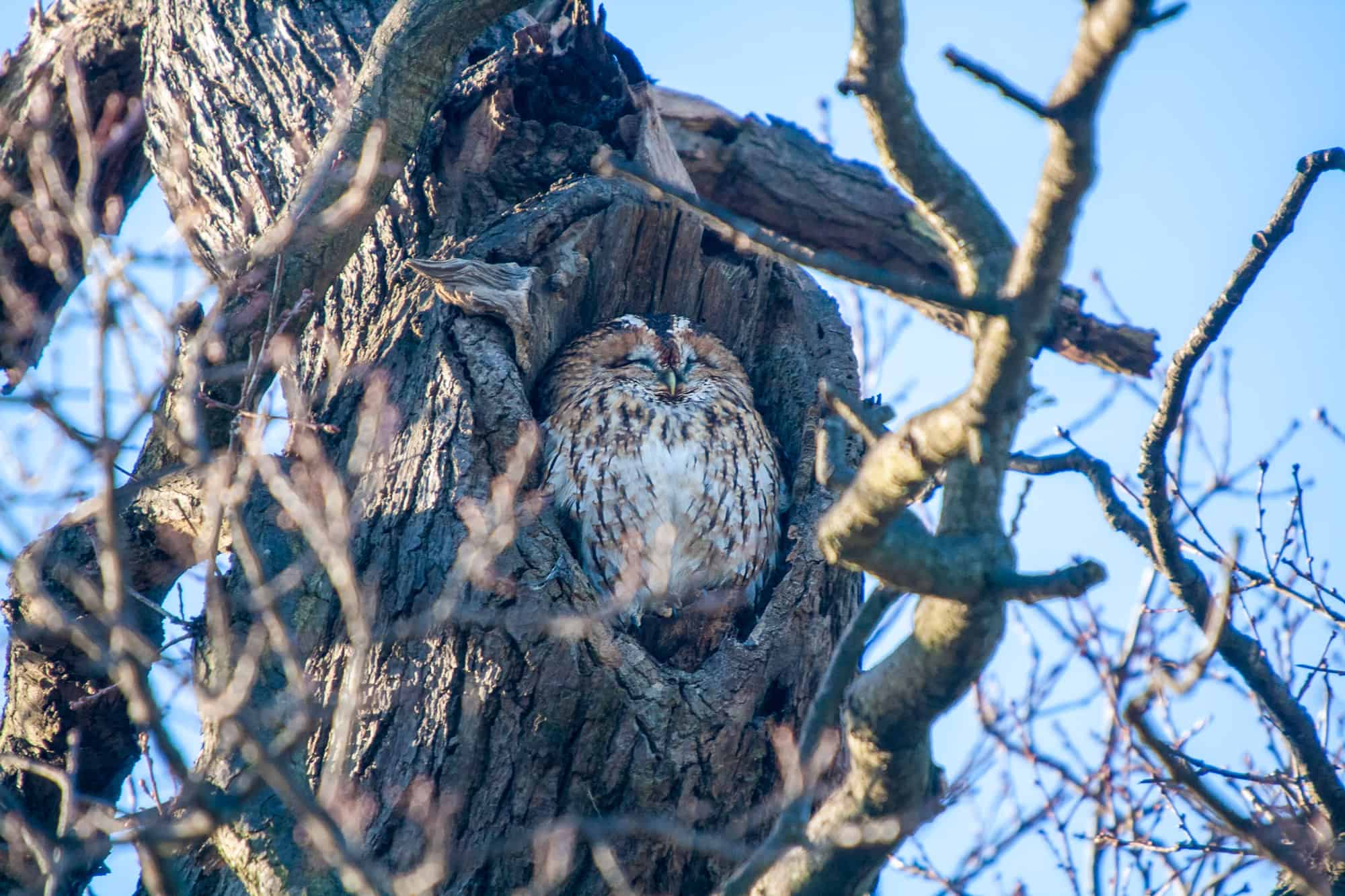
Tawny owls are sometimes called “fish owls” because they prey on fish.
©iStock.com/Rob Atherton
Evolution
Fossil records show that owls were present as early as the Paleocene era 60-57 million years age in the form of Berruornis and Ogygoptynx. They may have even been present earlier, at the extinction of non-avian dinosaurs – making them one of the oldest groups of land birds.
The Strigiformes expanded into ecological niches during the Paleogene while also evolving into their characteristic adaptations to many environments. By the early Neogene, all lineages had been displaced by other birds, leaving only barn owls and typical or true owls.
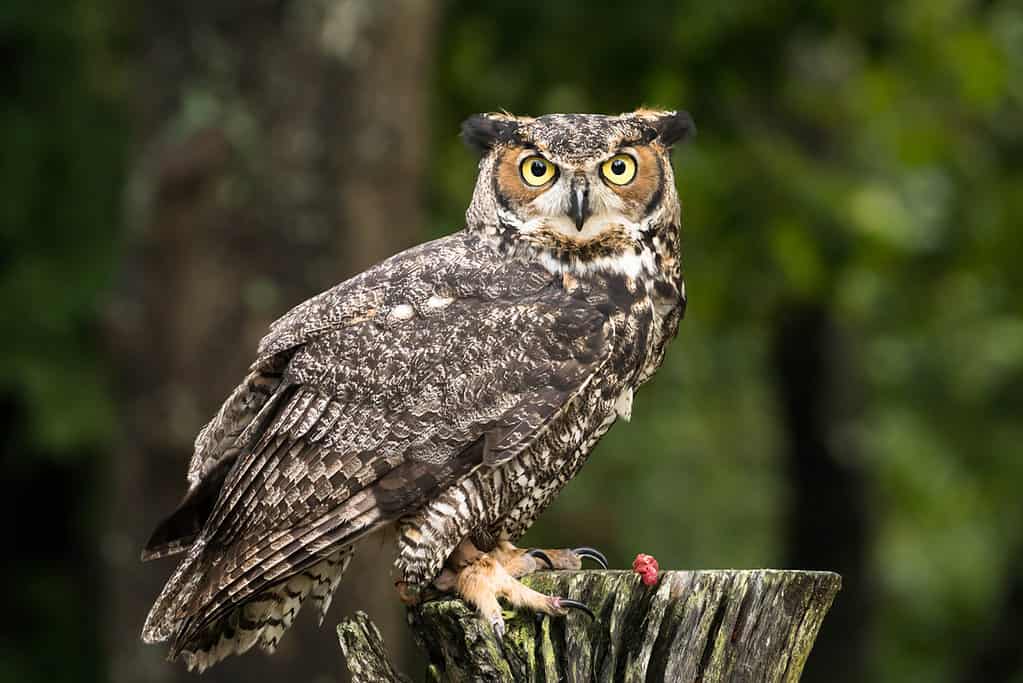
The great horned owl displays the characteristics of having a flat face, forward-facing eyes with facial discs, and sharp talons.
©iStock.com/makasana
Appearance
Physically, owls are a diverse bunch; they come in all kinds of different shapes, sizes, and colors which should make identification easier. There are nevertheless a few common features of these animals that unite them together. They possess a relatively flat face, a sharp beak, long and rounded wings, short tails, and two immobile, forward-facing eyes with facial discs around each one. These forward-facing eyes give them the depth perception and vision necessary to hunt exceptionally well in low-lighting conditions. Their feet have evolved with two forward-facing toes and two backward-facing toes. They are one of the few birds that can pivot the two back toes forward to grip and walk around.
Plumage is another one of its most important adaptations. It is soft, dense, and loosely hanging from the body. The upper layer of the plumage makes their flight almost perfectly noiseless. In northern climates, it also provides insulation against the extreme cold. The most common colors are gray, light brown, orange, black, or white, with a random adornment of streaks, bars, or spots, to help them blend in with the surrounding environment and avoid the detection of dangerous predators. Sometimes these colors make them almost indistinguishable from an ordinary branch upon which they perch.
Some species (like the horned owls) also have long tufts of feathers above the eyes. There are several compelling reasons why these tufts exist. One theory is that they may make the birds seem larger than they actually are to scare away predators. Regardless, the exact reason is not fully understood yet.
These birds differ greatly in their size. The smallest species in the world, measuring a mere 5 to 6 inches tall, is the elf owl. The largest species in the world, measuring more than 2 feet tall with a wingspan of some 6 feet long, is the Blakiston’s fish owl. In between these two extremes is the great horned owl, one of the most common species in the Americas, with a wingspan of about 4.5 feet long. Females tend to be slightly larger than males in terms of both body size and wingspan, but otherwise, they have a similar appearance, which can make identification a little difficult.

©Rafael Goes/Shutterstock.com
Behavior
Like many other types of birds, owls are most commonly found in single pairs or small family units. Together the same pair raises successive broods each year (though “divorces” have been known to occur if the pair is unable to produce enough baby chicks together). Sometimes they do form larger flocks outside of the breeding season for protection and safety. A group of owls is called a parliament. This term comes directly from “The Chronicles of Narnia” by CS Lewis.
These birds utilize a variety of different vocalizations and sound to communicate. When they want to be heard, they snap their bills, clap their wings, and call out to each other. This is often accompanied by exaggerated body postures such as bowing, bobbing, and dancing, which is most often seen in their mating rituals. While most species do hoot and chirp, there are a few exceptions. The barn owls make a hissing sound instead. The eastern screech owl makes a whinnying noise like a horse. The young offspring of the burrowing owl sounds like a rattlesnake. Some of these sounds are technically classified as songs. Duets can be important for reinforcing pair bonds between mates.

Unlike most owls that are nocturnal, Snowy owls hunt during the daytime and at night.
©iStock.com/Pasforward
Owls have unique adaptations that make them expert nocturnal hunters. This includes their binocular vision and sharp hearing. After leaving the roost around dusk, they move to their main hunting area and then spend a brief period of time creating songs. This is followed by half an hour of active hunting and even more songs. While most owls remain in the same habitat all year-long, some northern species (like the snowy owl) do migrate south with the arrival of winter.
A group of owls is called a parliament. Check out this article to find out why and how owls function in groups.
Habitat
Owls are found on every continent around the world except for the Antarctic. Grasslands, rainforests, woodlands, swamps, tundra, and other habitats all provide suitable homes for these birds. They nest in natural tree cavities, woodpecker holes, or cliffs. A few species nest right on the ground, but this is relatively rare.
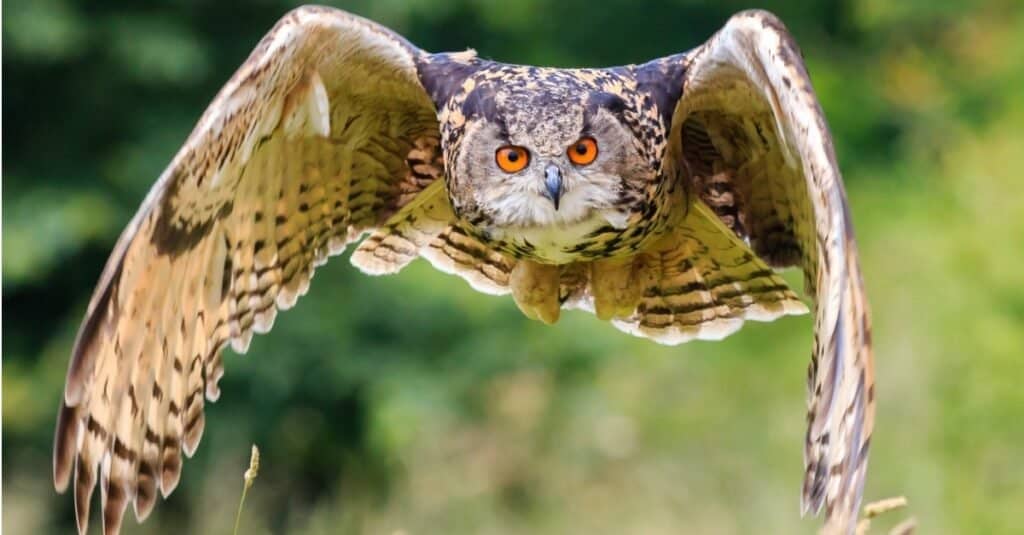
Like many raptors, eagle owls are top predators – they hunt other animals for food but no animals hunt them on a regular basis.
©Richard Whitcombe/Shutterstock.com
Predators and Threats
Besides their natural predators, these birds face numerous threats, including habitat loss, deliberate poisoning, hunting, vehicle collisions, and other accidents and disturbances. This has put more than a few species at risk of extinction.
What eats the owl?
Owls have only a few main predators in the wild, including humans, big cats, and other birds of prey. Sometimes they are even preyed upon by other species of owls. The great horned owl, for instance, is one of the most common predators of the much smaller barred owl. Their formidable size and excellent flight speed do afford them a certain degree of protection against predators.
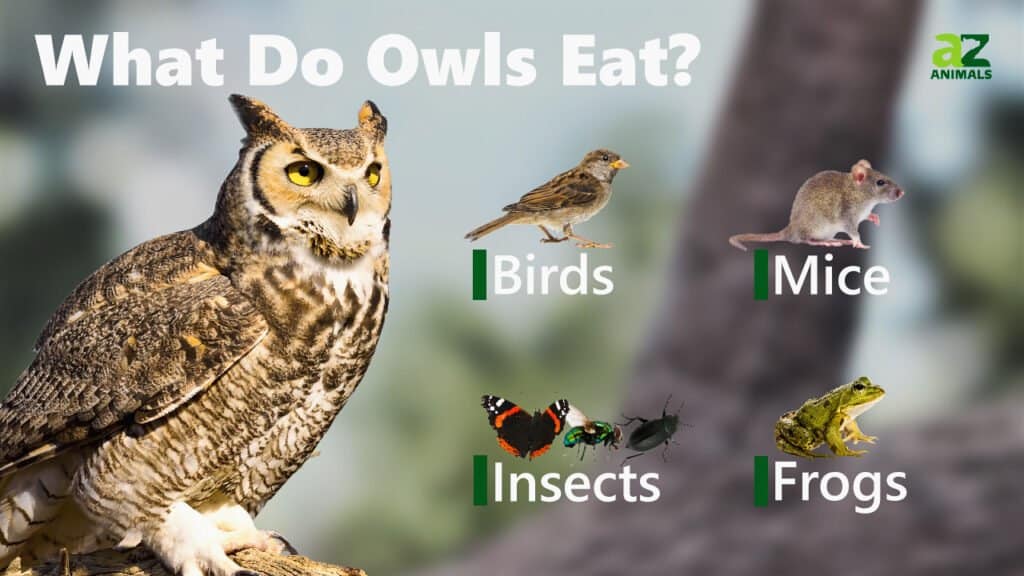
What does the owl eat?
The diet of the owl consists of only a few different prey items. Depending on size, most will feed upon rodents, rabbits, hares, and insects. They may eat snakes occasionally if they’re sized right, and some owls are specialized for catching fish as well. These birds are known for swallowing their prey whole, bones and all. Their exceptional vision is their main means of locating prey. One species can locate a small animal from up to half a mile away. These nocturnal hunters perch on a tall surface and swoop down to catch prey. At least one species is known to run rapidly across the ground, however.
Reproduction and Life Cycle
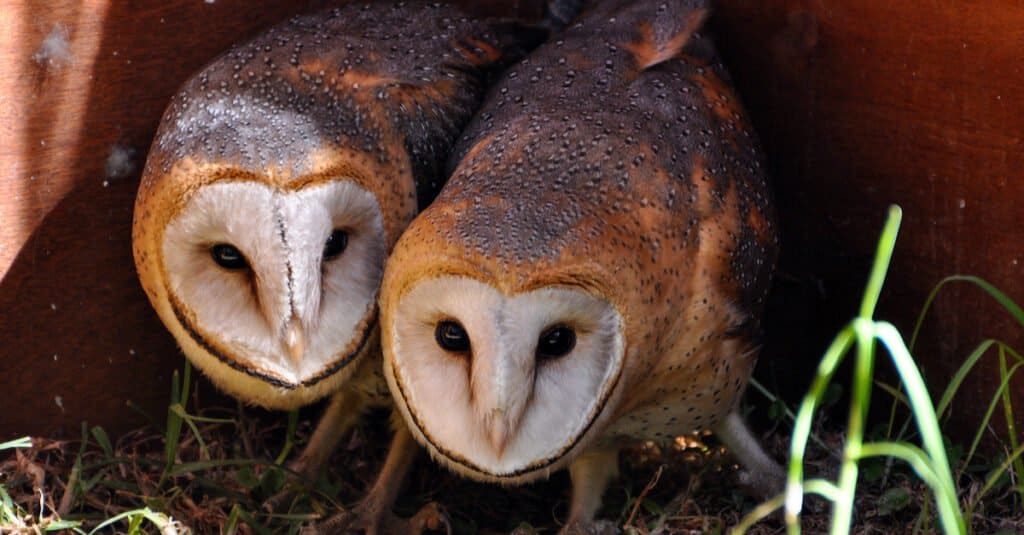
Once barn owls find a mate they only come together again during the breeding season.
©Mike Browne/Shutterstock.com
With a few exceptions, owls are thought to establish monogamous relationships. This means they tend to form long-term bonds with their mates that may last their entire lifespans. They maintain the same nest each year and even use it as a daytime roost in the non-breeding months. The nest generally consists of leaves, grass, fur, and feathers. Northern species tend to nest in the spring and time their egg-laying to coincide with the greatest concentration of prey in the warmest months.
The number of eggs will vary, but some species can lay a clutch of up to 12 eggs at a time. These eggs are laid a few days apart so they do not hatch at the same time. The oldest and youngest chicks can easily hatch two or three weeks apart. If food is scarce, then the youngest baby may be left to starve while the older siblings receive enough food to grow properly. The baby chicks may grow two successive coats or immature plumage. They will gain their full-flight feathers a few months after hatching and soon gain their full independence. Some species can live up to 25 years under ideal conditions, but the lifespan is often shorter than this in the wild.

Baby owls get their full-flight feathers a few months after hatching.
©Kurit afshen/Shutterstock.com
Population
Populations vary dramatically by species and location. One of the most common types of species is the common barn owl. As a species of least concern, it is estimated that there are some 4 million to 10 million of these animals worldwide. The great horned owl, which makes its home throughout the Americas, has an estimated population size of 4 to 6 million. Not every species is thriving, however. One of the rarest species is the Seychelles Scops-owl. Located only on the small Pacific island of Seychelles, it is estimated that only 200 to 300 mature individuals are remaining. This makes it critically endangered. Climate change could mean the end of this species.
View all 66 animals that start with OOwl FAQs (Frequently Asked Questions)
Is the owl carnivorous, herbivorous, or omnivorous?
They are carnivorous animals almost without exception.
What is the pronunciation of the word owl?
The English pronunciation rhymes with howl and scowl. Not every language is the same, however. The Spanish name for the owl is buho (the pronunciation is boo-oh). The French have two words to describe this bird: chouette and hibou. The latter describes the species with tufts, whereas chouette has no tufts.
What do owls eat?
Most species feed on a fairly small selection of foods, including rodents, rabbits, hares, and insects. Some are also specialized for a diet heavy in fish.
Is an owl a mammal or a bird?
With its feathered wings and strong but lightweight body, the owl has all the features of a bird. It is estimated to have evolved some 65 million years ago from earlier forms of birds. They began to seriously diversify into more modern forms some 56 to 34 million years ago. The closest living relatives are hawks, vultures, and other birds of prey.
What is the species name for an owl?
There are more than 200 species recognized from all over the world. All of them have their own unique species name. Some of the most well-known include the barn owls and the great horned owls.
Is it good luck to see an owl?
Because of its nocturnal behavior and ominous hooting sound, the owl has traditionally been seen as a somewhat dark force or a harbinger of death. However, not every culture saw them that way. To the ancient Greeks, this bird was associated with Athena, the goddess of wisdom. It even adorned the flags and standards of the city-state Athens. They were also seen as symbols of good luck and fortune in India.
Where do owls live?
They prefer to live in tree cavities, cliffs, barns, and other lofty locations all over the world.
Would an owl win the fight with a crow?
The battle of owl vs crow is an interesting one. One-on-one the owl would likely win the fight. But, owls are solitary and crows tend to form groups. A murder of crows might be too much for one owl to handle!
What are the key differences between true owls and barn owls?
The key differences between true owls and barn owls are appearance feeding habits, habitats, calls, and lifespan.
Would an owl win the fight with a hawk?
These raptors are both skilled hunters and the battle of owl vs hawk could be close. However, the fearless owl would likely win the fight.
How do owls sleep?
Owls sleep during the day. They find safe spaces to sleep, like tree hollows, and have a special adaptation called a halux, which is a back talon that helps them latch on and stay put in trees while snoozing.
Do owls poop?
Yes, owls make pellets but they also poop! Food goes in one way and comes out two ways. Owls poop out of their back-ends and regurgitate pellets out of their mouths.
How do you attract owls to your yard?
There are 10 easy steps to attracting owls to your yard. These include tips like: installing a nesting box, maintaining a perching spot, creating an owl ‘bird bath’ and more!
Thank you for reading! Have some feedback for us? Contact the AZ Animals editorial team.
Sources
- Britannica, Available here: https://www.britannica.com/animal/owl
- Audubon, Available here: https://www.audubon.org/news/13-fun-facts-about-owls

















